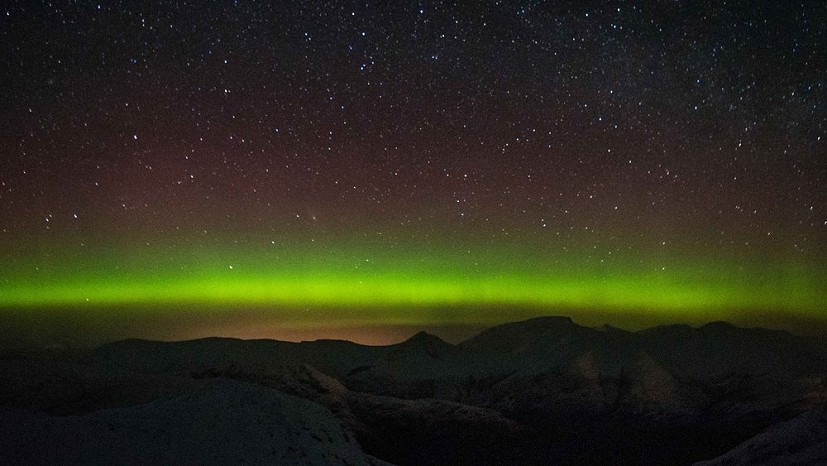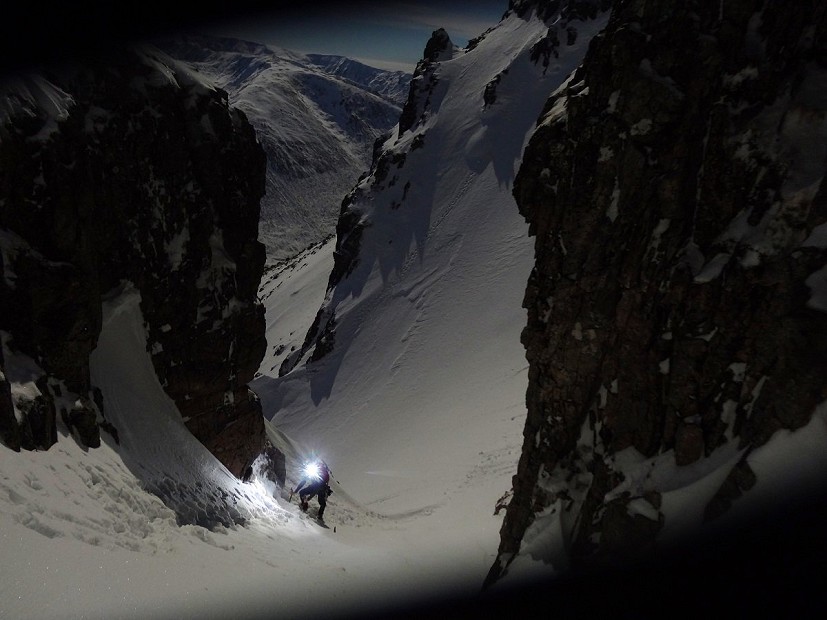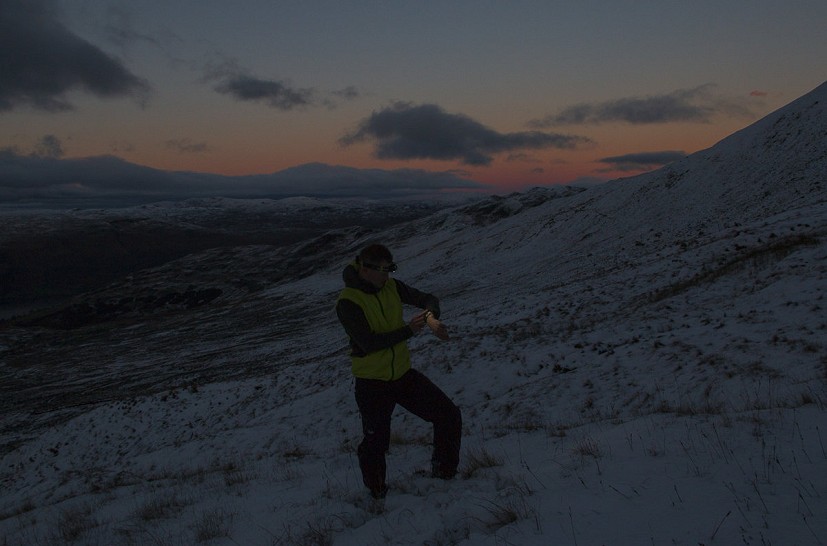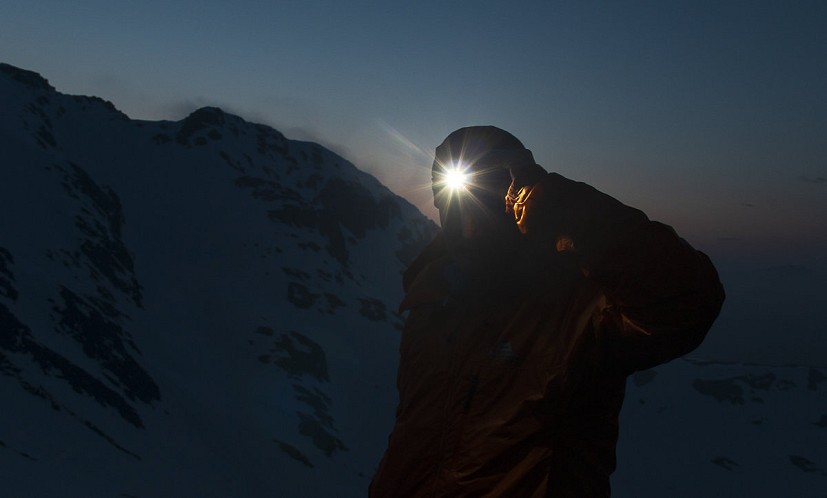Tips and Tricks for Navigating in the Dark
Finding your way around the hills at night is always going to be trickier than during the day. Hazards lurk unseen, small rocks take on the proportions of giant crags, and distances become harder to judge. There's a lot of darkness about in winter, and on a long hill day you're likely to find yourself walking in it at some stage. We rely so much on being able to see that it's easy to become disoriented, confused or spooked when visibility is reduced to the range of a headtorch. If you're navigating in the dark then some simple tricks and techniques can make all the difference.
Let there be light - and lots of it
No matter how honed your map skills, you won't get far without being able to see. Unless it's a clear moonlit night you're going to have to rely on the light you bring with you. A powerful, reliable headtorch is an absolute essential - and make sure the batteries are well charged before leaving home. Go for one that kicks out at least 100 lumens, with a good long burn time, robust build and easy operation. Instead of bringing spare batteries it's better to carry a spare torch, since this covers more potential situations (loss, malfunction and battery life).
Seeing is only part of the story - being seen is helpful too, whether it's a rescue scenario or you're just out in a group.
"Stick reflective tape to your rucksack straps so you are easy to follow by headtorch" advises Rachael Crewesmith, a Winter Mountain Leader and MIA.
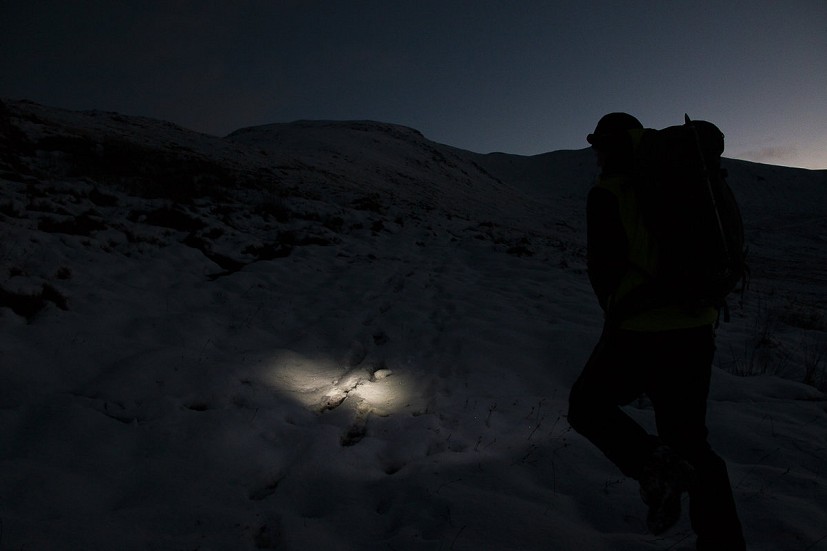
Beware red LEDs
Keep the torch off for as long as you can. To preserve night vision many models have a red LED for use at close quarters, but this can be a mixed blessing for map reading since contour lines can have a tendency to disappear in red light.
Use the tech
Yes you should always carry a map and compass, but at night on featureless ground even the best of us will have to admit to not always knowing, with utter certainty, our exact position. But your GPS device or smartphone definitely will. Slavishly following the screen is no way to spend your time outdoors, but there's no harm in the occasional check to verify or correct your map-based estimates. Once pinpointed, stick the device back in a pocket to preserve its battery, and return to the map and compass.
An altimeter (most likely a watch) can be worth its weight too. Narrowing your position down to a specific contour gets you a long way towards knowing your location. Now just work out the aspect of the slope you're standing on and nine times out of ten it should be fairly simple to locate yourself on the map.
Turn off the torch ...and put the compass away
If you're walking in a bubble of electric light then the space beyond your beam seems correspondingly darker, and it's easy to lose sense of the wider topography. Periodically switching off - and allowing your eyes some time to adjust - can help you regain an awareness of the lay of the land.
"Don't forget the terrain" says Rachael. "It's easy to get hung up on timing, pacing and following a bearing but paying attention to what the ground is doing is the most important thing. Try doing some nav legs without your compass....that's right...you heard me! Put your compass away and navigate using features alone. You will be surprised just how much you notice when you are not staring at your hand!"
Check your watch more often
If you're concentrating hard and stumbling about trying not to trip in the dark, time can seem to pass more quickly. Conversely, your speed is likely to be greatly reduced versus your daytime pace on the same terrain. Keeping a regular eye on the time is that bit more important at night.
Count your paces
Estimating distance is harder in the dark, and when everything outside the beam of torchlight seems further, and small landscape features can take on larger proportions - or be missed in the dark - it's easy to overestimate how far you've come. When you've less option for gauging your progress relative to distant features, you'll need to be more painstaking. Counting paces is a pretty reliable method of working out how far you're walking (so long as you've established the length of your stride in advance).
Break it down into bite-sized chunks
Navigating by visible features is a little different at night. In the day you might take a bearing on a distant mountaintop and follow it by sight, but at night the next rock or clump of grass might be your only visual cues. If the terrain is really featureless then consider leapfrogging, taking turns with your buddy to go out in front to act as something for the navigator to sight a bearing on.
Remember some key navigation techniques
This is a big one that deserves a box of its own. We asked Winter Mountain Leader Kate Worthington of RAW Adventures to run though some of her preferred low-vis tricks and techniques:
Attack Points
So you want to arrive at a bothy or specific area to camp for the night - and you're currently 1km away. You could take a bearing and walk in a straight line from where you are, to where you want to be, but you don't feel confident at walking all that way in the dark and keeping on your exact bearing. Fair enough: it becomes more difficult to remain accurate over long distances, when your visibility is so limited. You then notice that on the map there is a very obvious knoll/ring contour feature, that is 400m away, in a slightly different direction, but still taking you towards your end goal. If you navigate to this obvious knoll you'll have made it to an 'attack point', from which you can take another bearing towards your camp location. You will increase your accuracy by breaking up your journey, using an attack point like the friendly knoll. And maybe there's another attack point en route from the knoll to your hotel for the night...
Gathering Features (or Tick Features)
Have you ever watched Dora the Explorer? This children's TV character used 'tick features' in her cartoons by asking the audience to remember the features of a journey they were about to go on - just like we should do before we set off on a navigation leg in the dark. On your map, you've seen that your track will pass over a small footbridge, rise over a knoll and cross a field boundary before starting to descend quite steeply. You can track your progress along your navigation leg by 'ticking' off your identified features as you go.
Linear Features
A linear feature is (usually) a physical feature on the ground that you can follow in a linear fashion – in a nice, straight line. This could be a stream with no stream junctions, a stone wall or boundary fence (you'd want to know that the wall is actually there on the ground, rather than just historically depicted on the map – classic!). Or it could be a long, straight ridgeline. You can use these features to 'handrail' along your journey. So long as you are keeping track of distance covered and the terrain profile around you, linear features can be really useful. You can also 'handrail' along a contour. Ok, this is not a physical line on the ground, but if you have capacity to measure your altitude, then you can navigate keeping to this height, and thus keeping to the linear contour feature on the map. This takes some practise, but it's a useful technique to use along blank slopes with not many features to navigate between.
Aiming Off
It's a wet night and you want to reach that bothy, on a nice raised knoll beside the stream ahead of you. If you took a bearing direct from where you are to where the bothy is, you may veer off your bearing slightly in the dark and then you wouldn't know if the bothy is supposed to be on your right or your left, when you reach the stream. But when you're taking your bearing to a specific point, if you purposefully 'aim off' to one specific side of the feature, and then take your bearing to this point instead, you'll be on your chosen side of the bothy (to the east of the bothy, for example). In this scenario, when you reach the stream ahead you would know to turn in a westerly direction along the stream to walk back to the bothy. Dry night! This technique can work when your destination lies on a linear feature like a river, ridge or track.
Collecting Features
When you are planning your navigation leg from your map, look out for the really obvious features that will help you identify that you've reached the correct location. Is it a really obvious steepening on a shallow slope, or a very crooked bend in a stream? Look carefully at the features on your map and really imagine what they look like, given the information you have. If you have a clear picture of them in your head, you'll recognise them more easily when you bump into them in the dark. Thus, you have been 'collected' by the feature. Collecting features – they are like a big, well done hug!
Put in plenty of practise
A stormy night on top of The Ben isn't the best time and place for your first night nav in anger. Best to build experience and confidence in easier, less serious settings before pushing your skills to the limit 'for real'.
"Take snacks! High morale and lots of laugher is essential for night nav practice. Keep the atmosphere fun and you will learn a lot more" says Rachael Crewesmith.
"Even a wee hip flask to cheer everyone up goes a long way to making night nav more fun" ... yes, we bet it does Rachael.



